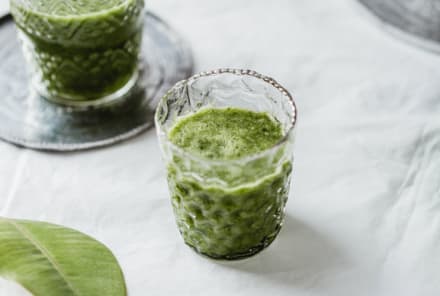Advertisement
Is Canola Oil Actually Bad For You? Here's What Nutritionists Have To Say


There’s no denying that some cooking oils have a better rap than others. Canola oil tends to receive less praise than other options like heart-healthy olive oil and avocado oil.
Yet, it’s fair to question the popular consensus and dig a little deeper before ruling canola oil out. Deciphering fact from fiction isn’t always easy, which is why we went to the experts and asked registered dietitians to set the record straight. So, is canola oil really that bad for you? Here’s everything you need to know.
What is canola oil?
Canola oil is extracted from the seeds of the rapeseed plant, which is part of the brassicaceae family1, as are cabbage and broccoli.
“The word ‘canola’ is actually derived from the title ‘Canadian oil, low acid,’ with the oil actually derived from rapeseed plants,” registered dietitian Whitney Crouch, RDN, CLT tells mindbodygreen. As such, the largest cultivar of rapeseed plants and manufacturer of canola oil is Canada, with the United States being its largest importer.
Part of the reason why canola oil gets a bad rap is that it’s highly refined (as are some other vegetable oils like corn, soy, and palm), meaning it goes through bleaching and deodorizing before it can be consumed. This process requires harsh chemicals (most commonly hexane), Crouch explains.
However, canola oil does have some redeeming qualities. Take note of its fat lipid profile, for example. Canola oil is very low in saturated fat and higher in Alpha-linolenic acid (ALA)2, an omega-3 fatty acid, than other cooking oils, registered dietitian Kelly Jones, MS, RD, CSSD, LDN tells mindbodygreen.
Canola oil has a mild, light, and neutral flavor and high smoke point, making it a popular choice for cooking and baking, as well as for processed and packaged foods.
Summary
Nutritional value
Here's what you'll find in one tablespoon of canola oil, based on USDA data:3
- Calories: 124
- Fat: 14 grams
- Saturated fat: 1 gram
- Monounsaturated fat: 9 grams
- Polyunsaturated fat: 4 grams
- Vitamin E: 2.44 milligrams (16% DV for adults)
- Vitamin K: 9.98 milligrams (20% DV for adults)
Canola oil is a cooking oil with high monounsaturated fat content (it has 62% oleic acid4), moderate levels of polyunsaturated fats (32%5), and low levels of saturated fat (less than 7%5). Canola oil has around 12% α-linolenic acid5—omega-3 fatty acids that Jones notes are healthy for your heart, brain, skin, and hair.
Canola oil has a high smoke point compared to other cooking oils (468 degrees Fahrenheit6) and an ideal 2:1 ratio of omega-3s to omega-6s6.
Different forms of canola oil
Here are a few of the different kinds of canola oil you'll find on shelves:
- Unrefined/Refined: When comparing unrefined vs. refined canola oil, the unrefined option is often going to be healthier. Refined canola oil loses some of its nutritional value7, whereas unrefined retains nutrients like vitamin E and a variety of antioxidants.
- Cold-pressed: Cold-pressed oils are less refined and have a greater content of healthy tocopherols and phytosterols6.
- Canola oil blends: You might also see blends that combine canola oil with other oils like olive oil, sunflower oil, canola oil, corn oil, and soybean oil.
- Rapeseed oil: Rapeseed oil is what they call canola oil in Europe.
Health benefits of canola oil
While it may not be the healthiest cooking oil, canola oil does offer a few benefits, such as:
It may improve hair and scalp health.
Canola oil is rich in monounsaturated and polyunsaturated fatty acids, which include omega-3 and omega-6 fatty acids.
“These fatty acids have been shown to have a positive impact on hair health by nourishing the scalp and strengthening the hair shaft8,” registered dietitian May Zhu, MBA, RD, LDN tells mindbodygreen. “The vitamin E content in canola oil also has antioxidant properties that can help to protect hair from damage caused by free radicals."
It may improve skin and support collagen production.
Canola oil contains sources of vitamins E and K, which both help support skin and hair health.
A review published in the International Journal of Molecular Sciences in 2017 summarized the potential benefits of canola oil for skin health9.
“The review highlighted the anti-inflammatory, antioxidant, and moisturizing properties of canola oil, and concluded that canola oil has the potential to be a valuable ingredient in skincare products,” Zhu says. “Vitamin K, in particular, can help support the production of collagen10 in the body, which is a protein that serves as the building block for skin and hair,” Zhu says.
Research also shows that Vitamin E in canola oil offers anti-inflammatory properties11 for healthy skin and promotes less exposure to UV radiation and other environmental pollutants. Vitamin E also benefits skin health and appearance by lowering the risk of damage from oxidative stress12, which can contribute to skin wrinkling.
It may support cardiovascular health.
“Canola oil is low in saturated fats (fats linked to an increased risk for heart disease13) and high in monounsaturated fats (fats that support heart health14) including omega 3 and omega 6 fatty acids, which is why it’s often mentioned that it can fit into a part of a healthy diet to support cardiovascular health,” Zhu explains.
One 2019 meta-analysis found that canola oil consumption reduced total cholesterol and LDL15 in participants older than 50 years old, suggesting that it could potentially postpone heart disease progression, Zhu notes.
What’s more, a recent study published in the journal Nutrients found that after 12 weeks of consuming canola oil, participants had significant improvements in metabolic profile16, including reductions in total cholesterol, LDL cholesterol, and triglycerides, as well as improvements in insulin sensitivity.
“These findings suggest that incorporating canola oil into the diet can have positive effects on metabolic and vascular health, which are important factors in reducing the risk of heart disease,” Zhu explains.
The downsides of canola oil
Here are the drawbacks of canola oil to consider:
It is commonly used in processed and fried foods.
Processed foods that contain canola oil tend to be high in added sugars, salt, and preservatives, which can contribute to several other health concerns, such as type 2 diabetes17 and high blood pressure18, Zhu notes.
“While [canola oil] is a more stable oil, it should be noted that when frying oil is used over and over throughout the day (like what may occur in restaurants), the composition of the oil can change to include a higher level of trans fats19, which are known to be less heart healthy20,” Crouch adds.
It may contribute to an excess of omega-6s in the body, depending on your diet.
While canola oil does contain anti-inflammatory omega-3 fatty acids, it also has omega-6 fatty acids. “A diet that is too high in omega-6 PUFAs and too low in omega-3 PUFAs (found in fatty fish, nuts, and seeds) can disrupt the balance of these fats in the body,” Zhu says.
Therefore, she notes, it's important to consume canola oil in moderation as part of a balanced diet that includes a variety of healthy fats.
It is susceptible to oxidation.
Canola oil contains linolenic acid21, which makes it susceptible to oxidation.
“Oxidation is a chemical process that occurs when the oil is exposed to oxygen, which causes the oil to break down and lose its nutritional value,” Zhu says. It can also lead to the formation of compounds that negatively impact health and well-being22, as well as minimize any anti-inflammatory properties of the oil.
To reduce the risk of oxidation, Zhu suggests storing your canola oil in a cool, dark place.
It is most likely genetically modified and treated with pesticides.
The plants that canola oil comes from are often treated with pesticides23 and/or genetically modified to enhance their resistance to pests and other predators.
“While there is no conclusive evidence that GMOs themselves are harmful to human health, some studies have suggested that consuming genetically modified foods24 may be associated with an increased risk of allergic reactions, antibiotic resistance, and other health issues,” Zhu says.
If you are concerned about the potential health risks of consuming GMOs or pesticides, Zhu recommends choosing organic canola oil, which is made from non-GMO rapeseed plants.
So, is canola oil healthy?
While canola oil is low in saturated fat and higher in heart-healthy fatty acids than some oils, it's still not the best choice for home cooking. It's often heavily refined and treated with pesticides and GMOs. Plus, it's used in large quantities in food preparations that are not as nutritious.
You're better off cooking with more healthful options like olive oil or avocado oil at home, and eating fried and packed foods that contain canola oil in moderation. Being mindful when dining out and reading labels on food products at the grocery store is one way to keep canola oil consumption in check. Balance the oil out with a diet that's rich in a variety of healthy fats, like nuts, seeds, and fatty fish.
If you do buy canola oil, look for one that’s cold-pressed or unrefined, rather than a highly processed oil or blend.
Canola oil vs. other oils
Here’s how canola oil compares to other popular cooking oils, based on factors such as smoke point and fatty acid profile:
Canola oil vs. olive oil
“Cold pressed extra virgin olive oil is an antioxidant-rich oil25 with a favorable fatty acid profile, including high levels of heart-healthy oleic acid,” Crouch says. Olive oil has a fat lipid profile of 14% saturated fatty acids, 73% monounsaturated fatty acids, and 11% polyunsaturated fatty acids.
For these reasons and more, olive oil is a healthier option26 than canola oil. However, its smoke point is lower, so it’s best used for drizzling or low-heat cooking, like baking and grilling.
Canola oil vs. avocado oil
Avocado oil is also a heart-healthy, antioxidant-rich oil with a similarly high smoke point to canola oil. Plus, it's less likely to be chemically treated, notes Crouch, making it a healthier alternative to canola oil.
Canola oil vs. vegetable oil
"Vegetable oil" is usually a combination of different oils. Crouch notes that like canola oil, vegetable oils also tend to be very refined. So they're comparable, but you might want to opt for canola oil so you know what's in it—and better yet, reach for a less refined option.
Frequently Asked Questions
Is canola oil safer than vegetable oil?
It depends on the type of cooking oil you choose. But in general, vegetable oils are highly processed blends that can have a bunch of oils in them. For this reason, canola oil might be a slightly healthier pick because you know what's in it.
Which oil is the healthiest?
Olive oil is the healthiest cooking oil for various reasons, including its perks for heart health, skin and hair health, and overall longevity and disease prevention. Jones recommends olive oil for its anti-inflammatory benefits and high-antioxidant power and considers it a kitchen staple. For high-heat cooking, avocado oil is also a very healthy pick.
Is canola oil worse for you than olive oil?
Olive oil is a more nutritious option for health and well-being than canola oil, Zhu says. That’s why she uses olive oil at home, when possible. Still, make sure to choose a good quality olive oil to really maximize its benefits.
The takeaway.
A verdict has been reached and while canola oil does have some healthy qualities, it is a far less nutritious option than other oils. Use it in moderation, limit your intake of highly processed and fried foods, and reach for these other healthy cooking oils instead.
26 Sources
- https://www.sciencedirect.com/topics/earth-and-planetary-sciences/canola
- https://pubmed.ncbi.nlm.nih.gov/8730609/
- https://fdc.nal.usda.gov/fdc-app.html#/food-details/1103863/nutrients
- https://www.ncbi.nlm.nih.gov/pmc/articles/PMC6398388/
- https://www.sciencedirect.com/topics/pharmacology-toxicology-and-pharmaceutical-science/canola-oil
- https://www.sciencedirect.com/topics/agricultural-and-biological-sciences/canola-oil
- https://www.ncbi.nlm.nih.gov/pmc/articles/PMC6296546/
- https://pubmed.ncbi.nlm.nih.gov/25573272/
- https://www.ncbi.nlm.nih.gov/pmc/articles/PMC5514576/
- https://www.mdpi.com/2076-3921/10/4/566
- https://www.ncbi.nlm.nih.gov/pmc/articles/PMC4976416/
- https://www.ncbi.nlm.nih.gov/pmc/articles/PMC9686906/
- https://pubmed.ncbi.nlm.nih.gov/26586275/
- https://academic.oup.com/ajcn/article/107/3/445/4939332
- https://pubmed.ncbi.nlm.nih.gov/30381009/
- https://www.ncbi.nlm.nih.gov/pmc/articles/PMC9416081/
- https://pubmed.ncbi.nlm.nih.gov/35022060/
- https://www.ncbi.nlm.nih.gov/pmc/articles/PMC8955286/
- https://pubmed.ncbi.nlm.nih.gov/27374582/
- https://www.ncbi.nlm.nih.gov/pmc/articles/PMC3955571/
- https://www.sciencedirect.com/topics/agricultural-and-biological-sciences/canola-oil#:~:text=The%20high%20level%20of%20linolenic,1)%20with%20one%20double%20bond.
- https://www.frontiersin.org/articles/10.3389/fnut.2021.717740/full
- https://pubmed.ncbi.nlm.nih.gov/22551191/
- https://www.ncbi.nlm.nih.gov/pmc/articles/PMC3791249/
- https://www.ncbi.nlm.nih.gov/pmc/articles/PMC7466243/
- https://www.ncbi.nlm.nih.gov/pmc/articles/PMC7427979/
Watch Next
Enjoy some of our favorite clips from classes
Enjoy some of our favorite clips from classes
What Is Meditation?
Mindfulness/Spirituality | Light Watkins
Box Breathing
Mindfulness/Spirituality | Gwen Dittmar
What Breathwork Can Address
Mindfulness/Spirituality | Gwen Dittmar
The 8 Limbs of Yoga - What is Asana?
Yoga | Caley Alyssa
Two Standing Postures to Open Up Tight Hips
Yoga | Caley Alyssa
How Plants Can Optimize Athletic Performance
Nutrition | Rich Roll
What to Eat Before a Workout
Nutrition | Rich Roll
How Ayurveda Helps Us Navigate Modern Life
Nutrition | Sahara Rose
Messages About Love & Relationships
Love & Relationships | Esther Perel
Love Languages
Love & Relationships | Esther Perel











